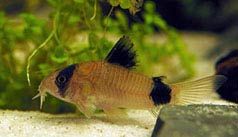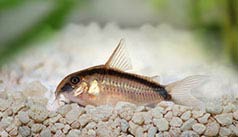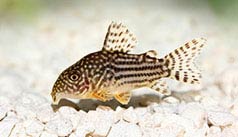

Adolfo's catfish
(Corydoras adolfoi)
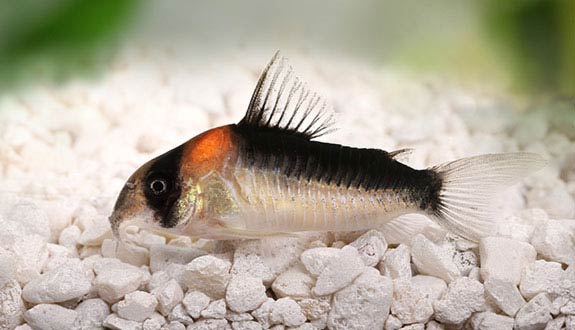
Thanks to Kyllian. As stated by Horlack's scientific article
> read
Alternative species (click on the thumbnail to see the card)
Names
Scientific name
Corydoras adolfoi
Common name
Adolfo's catfish
Adolfos Cory
Origin

Origin: Brazil
Biotope: Amazonian
Dimorphism

The female is more rounded, higher, and has rounded dorsal and pelvic fins, unlike the male where the fins are pointed.
Group

Callichthyidae
Volume

120 L / 26 imp gal / 32 US gal
Parameters

T°: 22 to 26°C or 72 to 79°F
pH: 5.5 to 7
Hardness: 1 to 10°dGH
Difficulty

Easy
Size

5.5 to 6.5 cm (2.2 to 2.6")
Longevity

3 to 5 years
Living zone

Middle and depth
Individuals

8
Food
How to feed this Corydoras?
Food
How to feed this Corydoras?
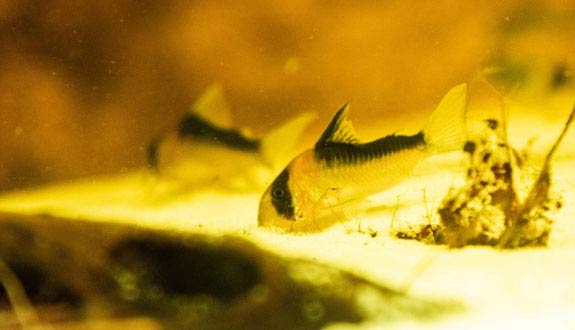
Its food will not be a problem because this fish accepts a wide range of food. It is just necessary for the food to be available at the bottom of the aquarium anytime. For this, the depth chips specialized in the stores will be very good.
However, it is important to vary its diet. To complete the basic diet, propose Daphnies, Artemia, Tubifex or even bloodworms that they love. Also make regular contributions in plants.
Also make regular vegetables additions: cucumber, zucchini, poached or boiled spinach, peas... Remove uneaten foods at night.
If your Corydoras are struggling to eat because other fish in the aquarium are faster, distribute their meal when the lights go out and watch if your Corydoras eat well.
Behavior
What kind of behavior does this Corydoras have?
Behavior
What kind of behavior does this Corydoras have?
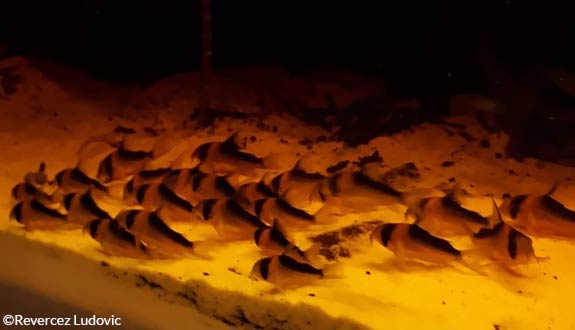
Very peaceful, this fish is never aggressive. It is also lively and active, spending most of its time stirring the floor frantically in search of its meal. It also likes to have fun, in the current, in the middle part of the aquarium, as well as along the windows. If your Corydoras are completely inactive during the day, it may be due to a problem of cohabitation (other species intimidate them), a too small number of individuals, an unsuitable aquarium or a current too weak. Check these points and you will see your Corydoras activate even during the day!
To make it feel good, it has to satisfy its gregarious instinct. Indeed, it will imperatively evolve in a group of 8 individuals minimum. Of course, the more there is, the better! So do not hesitate to put the maximum of Corydoras in your aquarium, according to your aquarium's volume. Regarding this point, it is estimated that:
group of 6 to 8 individuals: strict minimum
group of 9 to 13 individuals: correct viability
group of more than 14 individuals: behavior similar to natural
The more they will be, the more their behavior will be similar to the one they develop in nature, where the Corydoras form shoals of several hundred fish!
Even if the corydoras are very fearful, you can, with gentleness and patience, accustom them to your presence. For this, you must always make very slow and very calm gestures. When your corydoras do not flee you, it denotes a level of fulfilment, security and confidence well above normal!
Cohabitation
Who can live with this Corydoras?
Cohabitation
Who can live with this Corydoras?
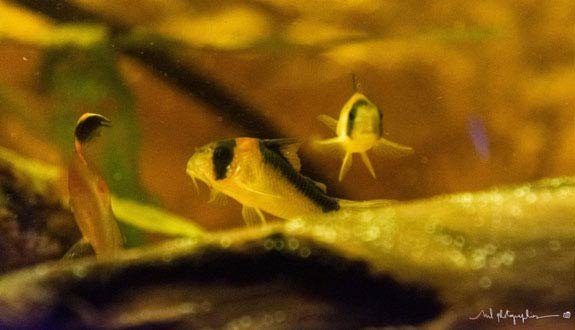
Like all Corydoras, the first choice of roommates for this fish will be its own congeners! Namely you cannot choose different species of Corydoras to form your shoal. Indeed, the Corydoras do not mix, and a Corydoras Adolfoi will not form a group with a Corydoras Julii for example. Your group must be composed of the same species.
In an aquarium with several species, it does not worry about the others, and does not have a problem of particular cohabitation. Choose very quiet roommates because Corydoras are easily intimidated by species that are too bright or too big. For example, Ember Tetra will make perfect roommates.
Note, however, that we must avoid too much food competition in the area of the bottom. It will be preferable that the Corydoras be the only species of this zone of the aquarium, and avoid Loaches and Plecos.
Breeding
How to breed this Corydoras?
Breeding
How to breed this Corydoras?
Breeding of this species is not particularly problematic. In general, a good change of water (50-70%) is enough to trigger spawning, which sometimes occurs spontaneously. Indeed, this drop in temperature simulates the rainy season of the natural environment. Repeat this process daily until spawning. In parallel, feed your fish abundantly with frozen or live prey.
The optimum age for breeding your corydoras is around 3/4 years old. Note that the older a female is, the higher the thickness of the eggs. They are thus more resistant and have a better chance of success, considerably increasing the number of fry. Before this age, you can get some fry all the same. If you want to make your corydoras breed, you understand the importance of installing them from the beginning in a suitable and well maintained aquarium, in order for them to live as long as possible, for a regular and successful breeding in quantity and in quality!
If you want to raise Adolfoi Corydoras and optimize the number of fry, plan a special tray dedicated to their growth. You can provide at least a small filter, a thin layer of fine sand (would lower the sensitivity of fry disease) and hiding (the fry are very fearful).
You then have two strategies:
Either you opt for the fish spawn in this aquarium, and you remove them in succession (it will then be necessary to provide several males for a female). Add large, stiff-leaved plants (eg Anubias) for the female to lay the eggs on.
Or the spawn takes place in the community aquarium and you can recover the eggs quickly enough to place them in the breeding tank (the Corydoras eat their own eggs).
You can treat the eggs with methylene blue for safety, but this is not mandatory.
The laying takes 2 to 3 hours and includes between 10 and 60 eggs. To avoid the appearance of fungus, you can treat eggs with methylene blue. Their incubation varies according to the temperature but will be on average from 3 to 5 days.
Fry food: infusoria, nauplies of artemia, flakes for fry or finely chopped.
Its aquarium
Which aquarium for this Corydoras?
Its aquarium
Which aquarium for this Corydoras?
In general, two parameters are essential for the Corydoras aquarium: a non-cutting substrate and good filtration generating current.
Firstly the soil: it is imperative to use very fine gravel or sand (like beach sand). Indeed, it was discovered in early 2018 that sand played a key role in the oral hygiene of Corydoras. In addition, by swallowing this sand at full speed and spitting it by their gills in order to look for food, the Corydoras get rid of any parasites that could be fatal to them. It is imperative to avoid sharp ground like quartz, which damages the barbels of your fish, and is going to mutilate them completely.
Then the current: more than the length of the facade, it is especially the current that is important in an aquarium for Corydoras. Indeed, they are excellent swimmers and are... athletes! So, steer a strong current on the "middle" area of the aquarium, leave the bottom and the surface with a little less current. You will see your Corydoras feast on going swimming against the current in this area (if no other species intimidates them)! For everyone to rest, lower the intensity of the current during the night or stop it.
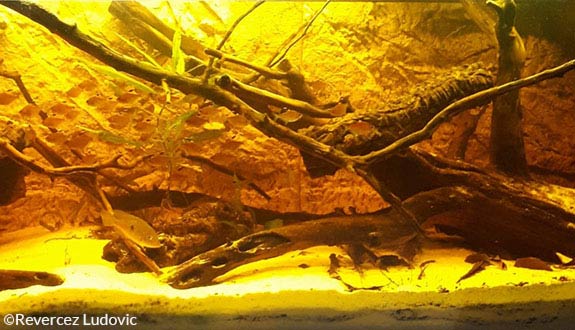
As for decoration, if you want to recreate the natural environment of the Corydoras Adolfoi and promote its well-being, create a decoration with driftwood roots that will form beautiful hiding places and do not plant too much. You can add alder fruits and dried leaves to the aquarium, which will have a nice natural effect (you will have to renew them before they rot). You can leave on a proportion of 50 to 80% of sand beaches essential for the search, 30 to 40% of wood and 10 to 20% of plants. If your fish are comfortable in your aquarium, they will not hesitate to move. A Corydoras that does not swim is a fish uncomfortable in its environment.
For plants, choose sturdy plants with slow growth and broad leaves. As fertilizer is strongly discouraged in an aquarium in Corydoras, opt for plants that do not require this type of feed.
Whatever your choices in terms of layout, still keep enough sandy beach to Corydoras so they can search the substrate.
Corydoras are quite sensitive to water pollution. Make water changes of 10 to 20% of the volume per week.
Good To know
Find all additional information!
Good To know
Find all additional information!
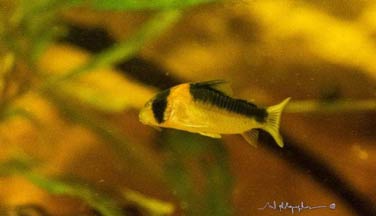
There are over 200 species of Corydoras! Moreover, it should be noted a risk of hybridization between Corydoras of the same line.
Corydoras are often considered "cleaners". It is true that they are scavengers but they will never replace the work of the aquarist! For example, it does not eat their excrement or that of other fish. Thus, these fish are often bought for "practical" purposes (which remains questionable) to the detriment of their well-being. But you will understand, the Corydoras are nice fish that deserve all your attention!
Corydoras Adolfoi has no scales, which makes it particularly sensitive to salt, chemicals and drugs. This also requires maintenance, clean water and stabilized parameters (do not introduce Corydoras in immature aquariums). IT IS NOT RECOMMENDED TO PUT FERTILIZER in a container containing Corydoras. If you notice signs of stress, such as fast breathing and then lethargy (stay still, sometimes near the surface), immediately change 50% of the water (provide a good water conditioner). Be careful, the new water must have the same parameters as the tank, including the temperature. If you isolate your sick fish, it may wilt even faster. Try to stick the hospital tray to the main aquarium so that the sick Corydoras can see its congeners.
Like all Corydoras, this species is able to swallow an air bubble on the surface. Indeed, it is a kind of "intestinal" breathing that allows the fish to supplement its oxygen supply when necessary.
Its barbels are used to search the ground for food. It is because of these «whiskers» that Corydoras are called «catfish».
Corydoras are capable of killing a human in exceptional conditions. Pay close attention to their backbones or pectorals! Depending on the species, they have hemotoxic toxins, hepatotoxic toxins, neurotoxic, etc. Did you know that they do not have a natural predator? It is thanks to this weapon with which they are able to kill their assailant in a very virulent way. Even the piranhas refuse to attack the corydoras! Here is a small zoom on their dorsal or pectoral spines:
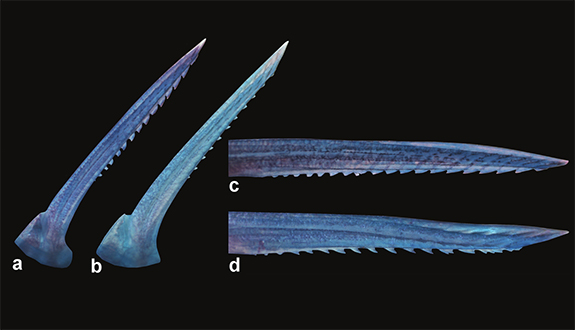
As you can see, in the case of a sting, it is impossible to remove the real sting, it’s like a real harpoon. In addition, the corydoras injects at this time a maximum dose of toxins. Rest assured, the corydoras are very much scared, so it is rare that a situation of deadly contact happens. Most of the time, they will flee for such a situation to happen. But be careful when you put your hands in the water!
Use a large mesh net to prevent stuck in it.
Corydoras wink, which is fun to see!
This Corydoras is rather robust and will make a good choice for beginners (except its price).
This species is often confused with a very close species: the Corydoras Duplicareus. In fact, the only difference will lie in the fact that the black band of Corydoras Adolfoi is thinner than that of Corydoras Duplicareus.
Yours photos!
Comments
Sort by:
Please login to post comments
